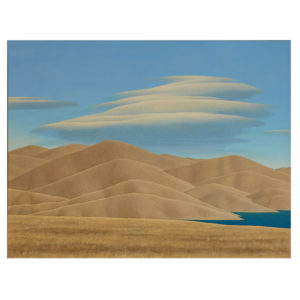Brent Wong
Brent Wong
Brent Wong
New Zealand (B.1945)
Brent Wong was born in Otaki in 1945, his family moved to Wellington in 1949 where they lived in a flat above his uncle’s shop in Vivian Street in the heart of Wellington city. The buildings of the inner city – their rooftops and architectural ornament – constitute dominant recurring motifs throughout his early work.
In 1965 Wong worked as a young copy-holder on Wellington’s Dominion newspaper. As well as providing the young painter with inexhaustible supplies of newsprint, the reading-room introduced him to a circle of writers and musicians and a motley assortment of intellectuals, political polemicists and malcontents traditionally attracted to newspaper reading rooms. The intellectual stimulus of these two years on the Dominion was reflected in his painting, engendering his deep abiding interest in philosophy and music. On the sheets of newsprint Brent drew the architectural ornaments and devices that fascinated him and through which he solved problems of perspective and chiaroscuro. These doodles were the forerunners of the motifs found in many of his paintings.
Influenced by Kandinsky, Klee and Turner (whose love of nature and the sky remain an inspiration), he explored the possibilities of black and white, watercolour and oil painting, before beginning to paint in acrylic in 1965.
During the late 1960s Wong perfected his remarkable draughting skills learnt from an early fascination with architecture. In 1967 he became interested in the work of American artist Andrew Wyeth and began a series of interior paintings featuring still life subjects.
1967 marked a turning point. That year eight drawings were accepted for exhibition at the New Zealand Academy; and, ironically, a prolonged period of illness enabled him to paint full-time. The bleak exterior of the building opposite his room was the subject of Window 1967, his first work to deal explicitly, if unconsciously, with claustrophobia, which in the paintings that followed was developed to a Kafkaesque intensity, giving his body of works an uncanny power.
Then in 1969, at twenty-four years old, Brent Wong hung twelve paintings at the then Rothmans Gallery – his first one-man exhibition. The impact of these surreal haunting enigmatic paintings, with their startlingly original imagery and excellence of production, excited critical attention. Overnight they established Brent Wong as an important New Zealand painter.
By the end of the 1960’s Wong was producing works with exterior scenes dominated by blue skies and architectural forms, which became increasingly surreal in appearance, floating across his painted skies. Between 1972 and 1977 these architectural constructions disappear and are replaced in his paintings by the predominance of landscape, buildings and clouds.
From this point on both technique and imagery were consolidated into a characteristic identifiable style; and his works evolved and deepened through the decades, gradually giving way to a more reflective and philosophical approach.
In 1980 he moved north to inner Auckland, and, while still retaining his distinctive surreal style, the light in his paintings has become more diffused in tone and his forms further simplified. In 1989 Wong moved out of Auckland to Muriwai Beach on the north west coast, it was during this period that he turned his talents to a series of meditative works depicting light and energy as a static image.
In 2008, in a final expression of surreal philosophical renunciation, he abandoned painting altogether to explore music composition, a field which had always fascinated him.
In his works Brent Wong uses a typical surrealist device of juxtaposing incongruous elements in his work and, although aesthetic considerations certainly are important to him, it is the clarity of the unintentionally revealed inner world which gives his paintings their extraordinary strength and wide appeal.
A constant factor in Brent Wong’s paintings is the sky. His clouds have a lofty permanence in a bright sky that is somehow at odds with their true nature, contrasting with a dry landscape below and irrelevant human activity. For him the sky is now a source of inner optimism, over-arching the dry and empty land. It is a source of joy.
Almost unique in New Zealand art, Brent Wong brings the spiritual and psychological together in a tense hallucinogenic landscape of real and imagined forms. He is deservedly among a very small cadre of New Zealand iconic painters who represent a generational sea change to true modernism.

